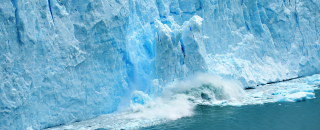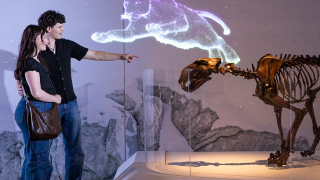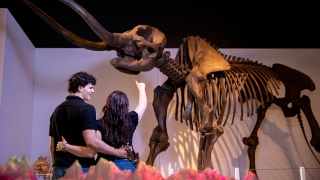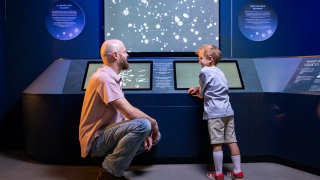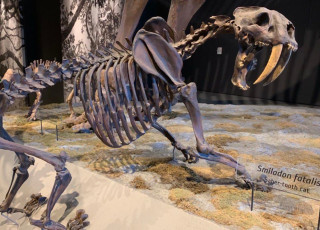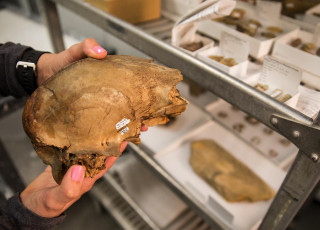Polar Patterns: Living in the New Ice Age
This article was published in advance of Mysteries of the Ice Ages, which opens Saturday, June 7, 2025 and closes Sunday, January 4, 2026. You can prebook tickets here.
By Olivia Barney
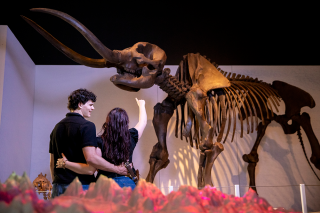
© Jack Rodgers/NHMU
When you think of an Ice Age, what comes to mind? Is it the witty banter from beloved animated characters? A planet that looks like one giant snowball? Or perhaps specific Ice Age animals, like the woolly mammoth, dire wolf, and saber-toothed cat. The Ice Age is a fascinating time in our Earth’s history, so between the towering glaciers and early human ancestors, there’s a lot that you could think of.
What probably doesn’t come to mind is the view outside of your kitchen window or the parks you drive past on your way to work — but believe it or not, we’re currently living in an Ice Age! Our planet goes through cycles that result in dramatic changes to our environment, and understanding these patterns helps us to predict what the future holds. So, what makes an Ice Age, what stage of this cycle are we in, and what can we expect for the future of our planet?
What is an Ice Age?
The answers lie frozen across the world. Simply put, if both the North and South poles have ice, we’re in an Ice Age. If at least one of the poles doesn’t have ice, we’re not in an Ice Age. Now, it might seem strange to imagine a time when there wouldn’t be ice at both poles, but that’s because modern humans have never lived during a time when there wasn’t ice!
We have to keep in mind that human history only makes up a tiny fraction of the history of the world, and an Ice Age doesn’t start and end in a matter of hundreds or even thousands of years. In reality, the cycles we know as Ice Ages last millions of years — and our Earth has experienced at least five of them! These cycles are affected by changes in Earth’s orbit in relation to the Sun, as well as other factors here on the ground.

One of several aspects of Earth’s orbit responsible for long-term climate change is known as obliquity, which represents the angle of the planet’s spin axis. The Earth’s axis is on a tilt that shifts subtly (less than 5 degrees) over the course of about 40,000 years! This tilt is why we have seasons and is one important variable that affects changes in our climate. Smaller tilt results in cooler summers and warmer winters, which can favor a “glacial period,” where ice builds up into glaciers that reflect more of the sun’s heat back into the sky, making the Earth colder and colder. This is how we get the stereotypical ice planet that traditionally comes to mind when we think of an Ice Age. Glacial periods produce cold, and often times harsh environments that require adaptation or ingenuity to survive.
A larger tilt can result in an “interglacial period,” which is the opposite of the scenario above. Winters are colder, which does result in additional glacier build up. But because the summers are significantly hotter, the extreme heat will melt most of it away. Interglacials are harsh periods in their own way, which is why the transition between these periods of the cycle can result in the extinction of even the most abundant species.
Are we living in an Ice Age now?
Over the course of our planet’s history, we’ve experienced at least five Ice Ages: the Huronian (2.45 – 2.21 billion years ago), Cryogenian (730 – 580 million years ago), Andean-Saharan (450 – 420 million years ago), Paleozoic (360 – 260 million years ago), and the Quaternary, which began 2.58 million years ago (that’s where we are today).

As mentioned above, each of these Ice Ages alternates between glacial and interglacial periods. The Ice Age we typically imagine (and the one that sets the scene for the Ice Age franchise), is known as the Pleistocene glaciation. It began around 2.58 million years ago and ended with the present interglacial period that began about 11,700 years ago. This interglacial period is known as the Holocene, and it’s the stage we’re currently living in.
The transition between the glacial Pleistocene and interglacial Holocene was associated with the extinction of giant, furry animals which evolved to survive in bitter, cold temperatures — though the changing environment wasn’t entirely to blame. Early people hunted some of these larger mammals, perhaps speeding up their ultimate extinction.
When will we see the next “Ice Age”?
Though we’re already technically living in an Ice Age, questions often arise about when we’ll enter the Earth’s next glacial period. Will we live to see the planet covered in frozen water? What will happen if we do?
Thanks to mathematicians and astronomers who are tracking changes in the Earth’s orbit about the sun, we can make general predictions about when to expect the next icy era. Based on current orbital parameters, the planet should be cooling, following a long-term trend that began ~6,000 years ago.

But temperatures aren’t dropping the way they should. People are altering the pattern, introducing unanticipated factors that affect our climate. Glaciers, for example, should be growing under traditional circumstances, but instead, they’re melting. The impact seems small when compared with our relatively short lives, but there’s no telling what that impact might have across geological timescales.
The History of Ice on Planet Earth

Mysteries of the Ice Ages explores the past, present, and future of ice on our planet, helping visitors take a deeper dive into the many vital roles ices plays on the Earth. It highlights the seasonality of life and the creative ways some species have evolved in order to adapt to their environments. The warm fur of mammoths, fat insulation in giant ground sloths, and patterns of hibernation for short-faced bears are just a few of the many adaptations that allowed these iconic species to endure the glacial Pleistocene. But what happens when conditions change so rapidly that a species can't adapt? The later portion of the exhibition answers those questions too.
Extinction is a natural process that all species will experience. But sometimes this natural process occurs at an unnatural speed. Mysteries of the Ice Ages raises awareness about this possibility, highlighting that the current rising temperatures have put over one million species at risk of early extinction, including the one of the most iconic cold-loving creatures: the polar bear.
Polar Bear Populations on Thin Ice
Polar bears rely on glacial ice sheets to survive. These massive predators require a lot of food to fuel their bodies and to produce the fat that keeps them warm. Most of their calories are consumed in the form of seals, though they have been known to eat other animals if available. Seals carve dozens of holes in the ice which allow them to surface for air as needed.

Polar bears carefully crawl across the ice, staying low on their bellies, to hunt seals when they surface. As ice sheets continue to melt and disappear, polar bears are at the mercy of seals and whales that wash up on the beach or birds that happen to land nearby for a rest.
And while polar bears could potentially evolve their diets to be less reliant on seals, the resources available to them on land are far less consistent — let alone capable of sustaining the caloric intake a polar bear needs. But though polar bear numbers are dwindling, they’re far from the only species at risk.
Here in Utah, several species are feeling the ripple effects of a warming world. Aspens, Utah's state tree, live in communities with a shared root system. They're found in every country across Utah, a beautiful and vital member of many ecosystems across the state. As temperatures increase (even by small degrees), aspens become more susceptible to drought, and hotter temperatures can also increase the risk of wildfires or extreme heat waves.
For Utah's mountain dwelling critters, the high slopes of our Montane forests are like island oases. The climate in those higher elevation areas provides cooler temperature and more moisture in the form of rain and snow. Animals like the elk, Stellar jays, and garter snakes call the area home, and have adapted to live in a specific set of conditions.
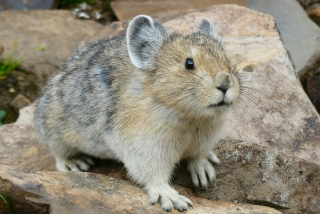
Take the pika for example. Pikas are small, adorable mammals that look a bit like hamsters but are more closely related to rabbits. They dwell in these alpine areas but cannot survive temperatures above 78 degrees. As average temperatures in Utah increase, pikas, and other mountain-dwelling friends, are faced with an unexpected challenge: There isn't a higher, cooler peak to migrate too, and moving to a lower elevation only comes with warmer weather. Fortunately, there are simple, attainable actions we (as individuals and communities) can take to protect at-risk species — reminding us that there's always a good reason to have hope.
Mysteries of the Ice Ages inspires visitors with simple, practical ideas on how to counter unnatural climate change — no matter your age or circumstance. It's an inspiring encounter with the frozen world that will leave you in awe.
Protecting At Risk Species Through Simple Efforts
The basis of any good conservation efforts begins with education. Get familiar with the science behind Ice Ages and their cycles, appreciate the majesty of our Earth’s natural cycles and patterns, and find out what small efforts each of us can make to care for our home — starting right here in Utah. You can learn it all (and more) in NHMU’s newest special exhibition, Mysteries of the Ice Ages, which opens Saturday, June 7, 2025. It’s an immersive, hands-on experience unlike anything you’ve seen before. Prebook your tickets now and explore the exhibition through the link below. The exhibit is open through January 4, 2026.
Get a Sneak Peek of Mysteries of the Ice Ages
1 of 4
